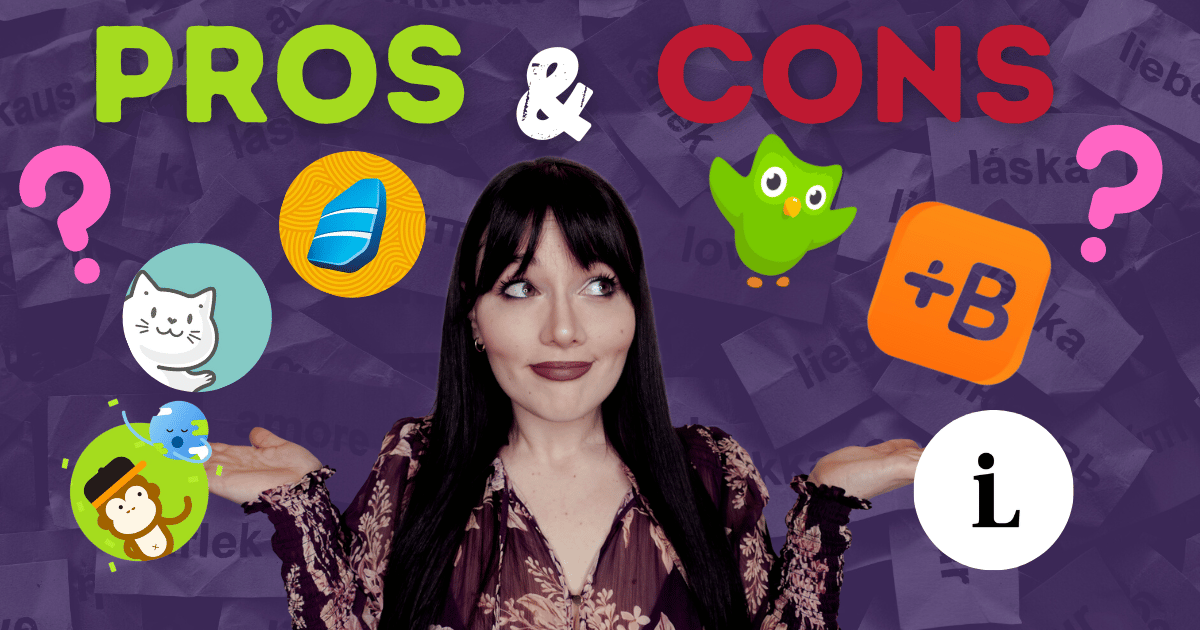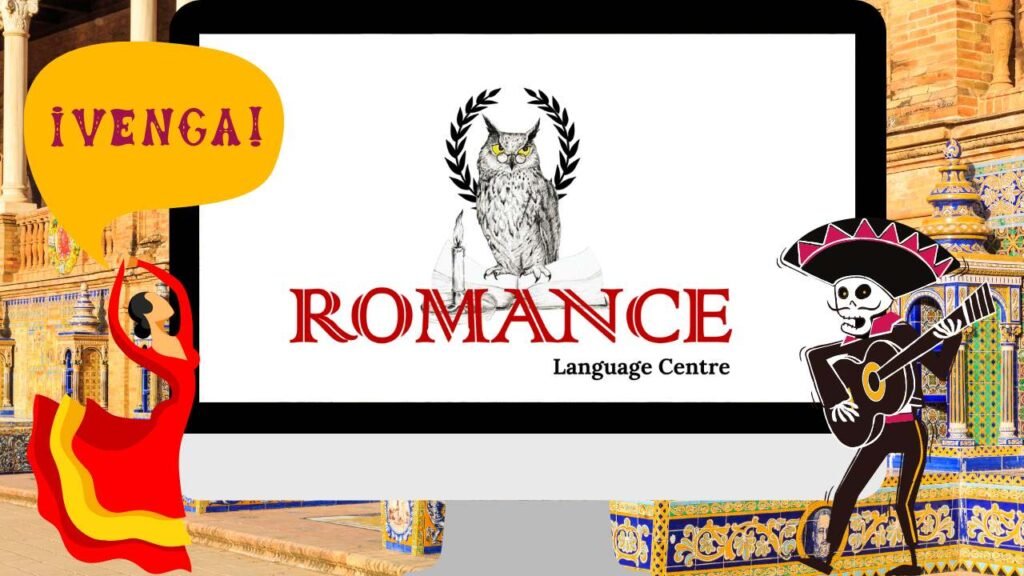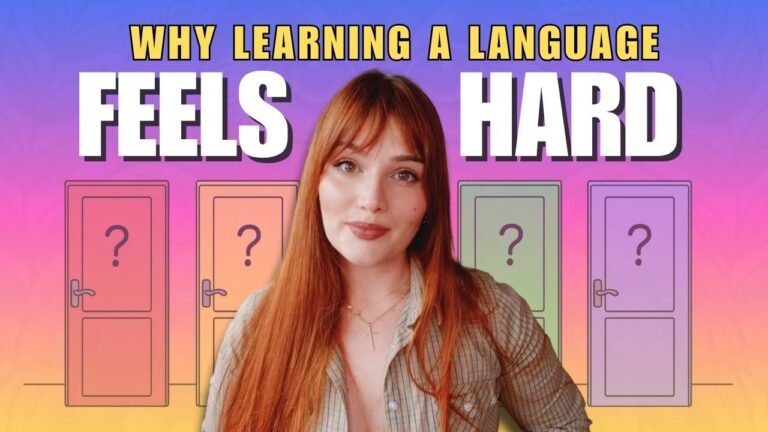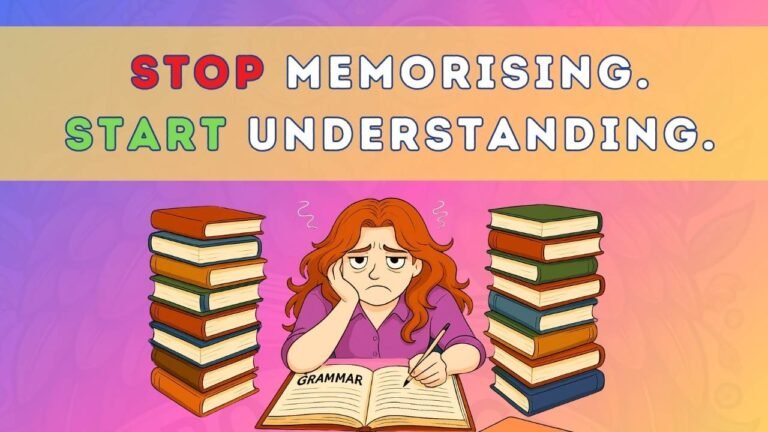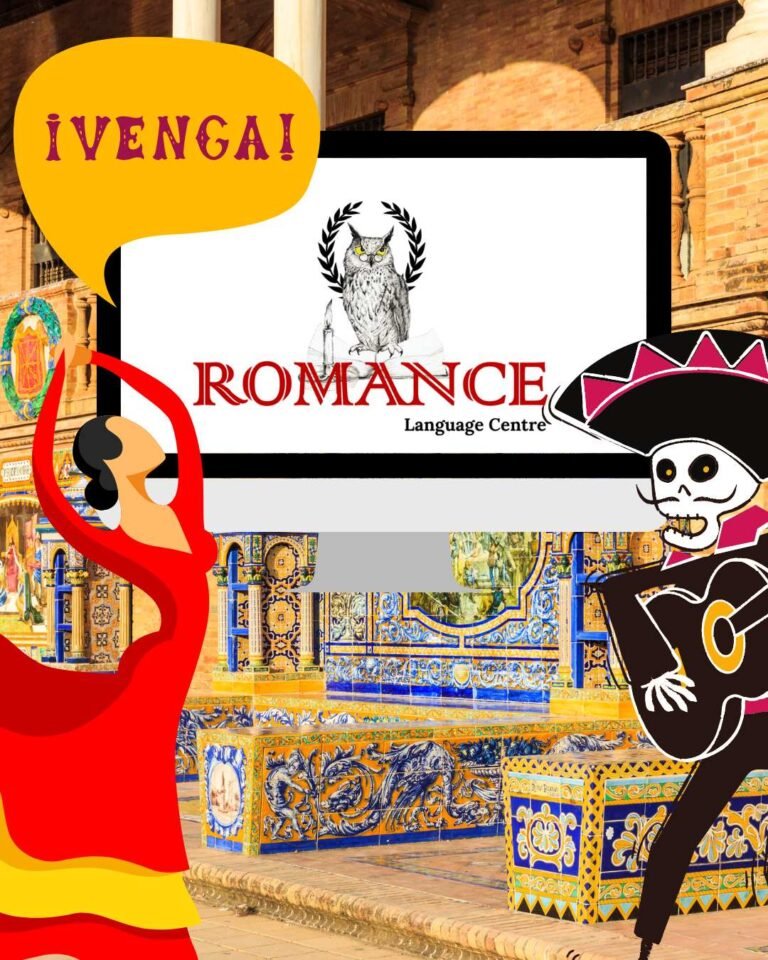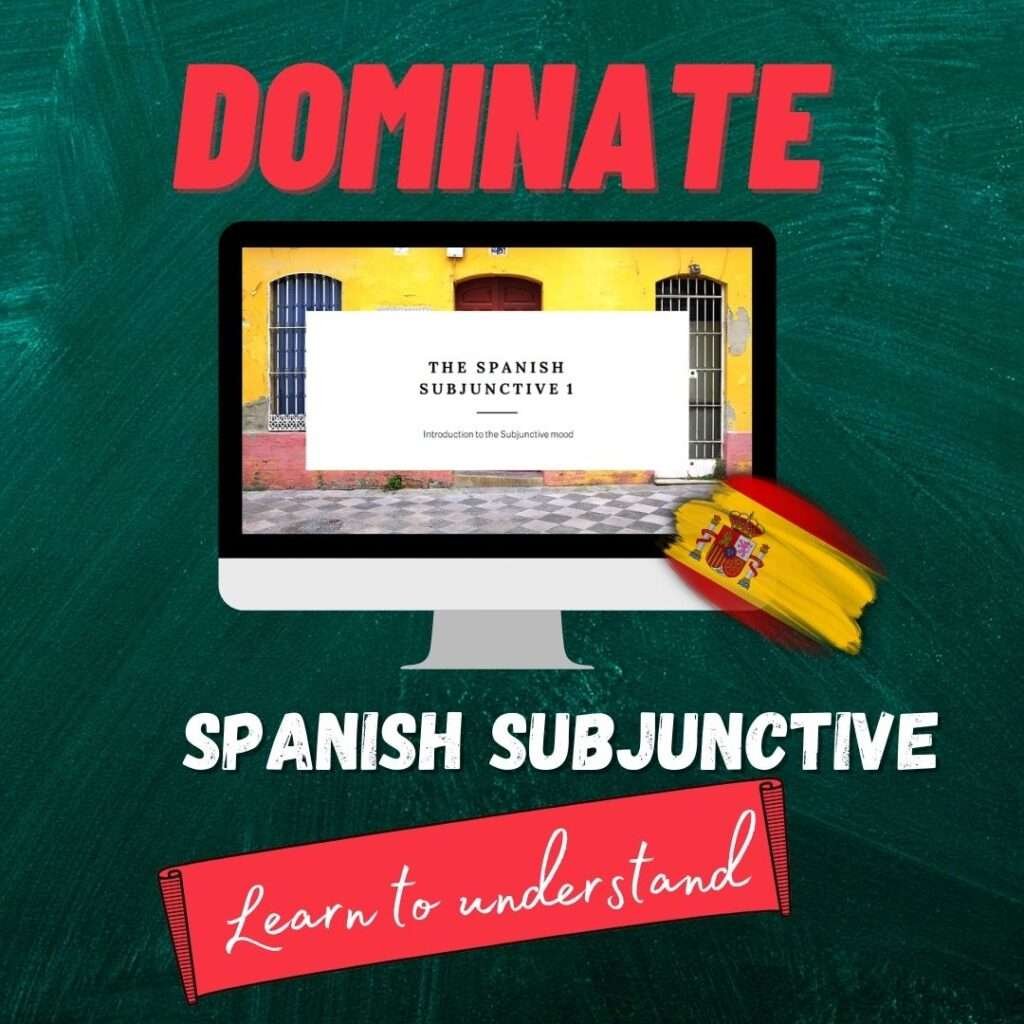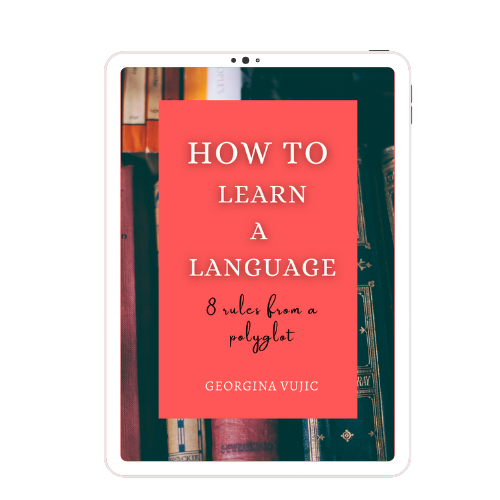If you’re new at learning languages, you must know that the most common advice given to newbies is to use language learning apps like Duolingo to learn a language quickly.
Every now and then, however, we see a learner openly saying that maybe that language just isn’t for them, going as far as saying they feel dumb or incompetent because everyone but them seems to be making a lot of progress very quickly.
On the other side of that, there are people swearing by these apps and boasting of their easily acquired fluency.
This is a topic we often write about as it’s become something of a phenomenon in the language learning community. So much, in fact, that a new term has been coined: the illusion of fluency. The illusion of fluency is very much real and has become a problem. To learn more about it and the damaging effect it has on the community, you can read a more in-depth analysis in our article How Long Does It Take To Really Learn A Language?
It is safe to say that the belief that apps are the best way to master a language has become wide-spread. But, are they really? Is there validity to these claims? What is the role of apps in the process of language learning? Is there more truth to them than what is said through paid sponsorships?
As professionals who truly care about their students, we have taken it upon ourselves to try out and review some of the top language learning apps on the market. Let’s see if all language learning apps are created equal or not.
In this article, we bring you a review of some of the most popular apps such as Duolingo and Babbel, and other not so well-know ones. We’ll talk about the pros and cons of each one of them and how and whether you should rely on them at all.
We’ll pay special attention to the way these apps advertise themselves. What is their ethnos and do they actually deliver on their promises? Integrity is something that’s rarely talked about when it comes to selling a product. This is a shame because the lack of it can be very misleading and deceitful for someone who doesn’t know much about what it really takes to learn a language.
So let’s start from the most popular one.
DUOLINGO

This is without a doubt the most popular language learning app and one of the most downloaded educational apps in general. One of the factors that contribute to its ever-growing popularity is the fact that it’s completely free, and who doesn’t like free stuff?
There’s the option to upgrade for $84 per year which equals $7 per month, but that mostly just gets your rid of annoying ads and gives you unlimited hearts (hearts=mistakes, meaning you don’t have to go back or leave it for the next day), there aren’t that many extra benefits to the actual language learning itself. And that is exactly where the problem with Duolingo lies.
If you go to the Duolingo page on Facebook, you’ll see that most comments aren’t talking about learning a language at all. Instead, they mostly concern themselves with other people cheating, knocking them off their place in the league, the gems, the hearts, the points that aren’t working correctly, asking for more outfits for the Duolingo owl…You get the idea. Has it always been like this? And what does Duolingo really stand for?
HISTORY AND METHODOLOGY
The app was created by Luis von Ahn, professor at the Carnegie Mellon University in Pittsburgh. Originally from Guatemala, he witnessed first-hand how difficult it was for Latin Americans to learn a new language, especially when so many of them fled to the United States due to difficult circumstances. According to von Ahn, his app was founded on the idea that free education would change the world.
However, the gamification aspect of Duolingo was becoming more and more prominent with years, until it became just that – a game. Duolingo is based on repetition and translation of stiff formulas and phrases, the so-called immersion method, meaning – no real methodology.

What happens when you attempt learning, or doing anything, for that matter, without a well-established methodology? Read a detailed experience by someone who tried to learn Italian just with Duolingo: How to Almost Learn Italian.
The article also brings up another interesting point. When the author confronted Luis von Ahn about his experience, he just laughed and said that the app had done exactly what it was supposed to do: it kept him ‘hooked.’
This statement goes against Duolingo self-promotion as the ‘world’s greatest way to learn a language.’ It’s also contradictory to the studies claiming that Duolingo can replace studying a language at the University. We have discussed Duolingo’s claims and marketing schemes before in our post titled: Is Duolingo truly the “World’s greatest way to learn a language”.
Therefore, Duolingo might be the world’s most addictive way to make you think you’re learning a language, but it is definitely not the world’s best way to learn a language, as the creator himself has admitted.
DUOLINGO’S PROS
So is there anything good about Duolingo that you could use?
One of the reasons why Duolingo is still so massively popular is because it’s constantly upgrading. And while the app itself lacks at providing cultural context, Duolingo has created podcasts for some of the languages, which we recommend for bettering listening skills and developing cultural awareness.
Just be careful, as listening is just a part of learning a language. You will never learn it by just listening, you must focus on developing all 4 skills (writing, speaking, listening, reading) equally. Otherwise, you run the risk of developing only passive knowledge that never leads to fluency.
Also, bear in mind that not all of the languages on Duolingo are equally supported so the podcast is only available for the widely spoken languages.
PROS:
- availability
- podcasts for some languages
CONS:
- games over quality and functionality
- dishonest representation
- lack of cultural context and effective methodology
BABBEL

The market is currently saturated with so many language-learning apps promising the same thing, but did you know that Babbel was the first one? It originally launched as a web-app in Berlin in 2008 and currently counts with 10+ million subscriptions.
But wait, you might say, how come the pioneering language app has a lot less subscribers than Duolingo?
This is mostly due to the fact that Babbel is paid-only while Duolingo is completely free unless you want to upgrade. Babbel also has a lot less languages to choose from, 14 in total and the standard Babbel subscription is valid for learning just one language at a time.
You do, however, get the trial for free so I was able to test it out for you. Here are my thoughts.
QUALITY OVER QUANTITY
Having lots of languages to choose from is a great thing, especially if you’re aiming at some of the less common ones, but the problem with that is that they’re usually not as well supported as the more wide-spread languages like Spanish or English.
Duolingo, for example, has started introducing grammar tips, little explanations about grammar rules, but only for the most common languages. I’ve chosen an Indonesian course with Babbel and found that it’s quite well supported.
METHODOLOGY
The method of teaching is more traditional with less of the gamification aspect, although games are available in a separate section.
We believe this was a smart move because you’re not preoccupied with earning points as you progress through the lessons themselves. Once you’ve acquired a certain amount of vocabulary, though, you can try to save the professor from being eaten by ghosts through the correct use of sentences or spell the word before the train runs off the tracks. Those are games in the true sense of that word.
So what do lessons look like then? The order and the structure of the lessons is similar to what you’d find in a textbook.
There are six memory stages for learning vocabulary, using the technique of spaced-out repetition. Babbel doesn’t show you how to use the newly acquired word within different or personal contexts so that’s a slight disadvantage because independent and varied use is a crucial step in the process of learning a language. It does, however, offer some explanations on things like types of greetings (whether you expect to see the other person again soon, etc.).

AUTHENTIC AND REAL VOICES
It also prides itself on using voices of native speakers with various accents, instead of using computer-generated audio.
And while learning vocabulary through repetition is nothing new, what I like about Babbel is that it doesn’t just ask you to repeat what you hear, it does actually teach you rules of pronunciation, albeit very gradually. This will allow you to produce independently later on which should be the ultimate goal. It is the only app where I saw a section dedicated to just that, so that’s a big plus in my book.
CULTURAL CONTEXT
Another thing I like is that it incorporates cultural context in its lessons. At the very early stage, I learned Indonesian national motto, a little bit about its geography and the ethnic groups that live there. You can also find a magazine about different aspects of Indonesian culture and language separate from the lessons.
Cultural context is something that isn’t discussed as often as it should be when talking about language apps, but the fact remains that it’s an indispensable part of learning a new language. It helps you connect to the people whose language you’re learning and it keeps you motivated to do more.
BABBEL VS. DUOLINGO
Since these two apps are so often compared, I’ll do a quick comparison based on my professional opinion and research. While I don’t believe that any app is a be-all solution to language learning, Babbel does perform better than Duolingo.
This is mostly due to the fact that Babbel’s lessons were tailored by the in-house linguists who have focused on developing the languages they have to the same standard and with an effective methodology.
What fuels Duolingo then?
Duolingo is a crowd-sourced language content, meaning, it relies on volunteer contributors who are not necessarily experts by any extent. You’ve probably seen people posting and joking about the ridiculous translations they’ve been tasked by the Duolingo owl. Well, this is why.
And if you’re wondering how Duolingo sustains itself if it’s free, it’s because every time you translate something, that’s sold to companies like Buzzfeed and CNN. Babbel, on the other hand, operates entirely off paid subscriptions.
So is there something Duolingo does better? There is one thing I think Duolingo wins at, although it’s outside of the app: the podcast.
More precisely, I’ve compared the Spanish podcasts on Duolingo and Babbel since that’s my field of expertise. And I have to say, the Spanish podcast on Duolingo seems more condensed and learning-oriented through stories.
Babbel’s podcast is more relaxed, in the style of a conversation/discussion between two people. They sometimes discuss topics from other languages such as pronunciation in German, which probably won’t interest you or you’ll find difficult to follow. After all, you’re there to learn Spanish.
PROS:
- all languages equally supported
- great attempts at developing an effective methodology through app learning
- cultural context
- grammar tips
- pronunciation rules
- higher chance of developing linguistic independence in use
CONS:
- subscription only covers one language at a time
ROSETTA STONE

If you’ve researched language learning apps before, then you know it’s always a race among Duolingo, Babbel and Rosetta Stone. Let’s see how Rosetta Stone operates and how it compares to the other two.
CAN I BECOME FLUENT THROUGH IMMERSION ALONE?
We’re going to start from the company ethos and methodology.
So here’s a couple of things here that really drew my attention.
‘By far, the most complete solution to learning a new language.’
This is quite a bold statement. And while every company ad will say something among those lines because their ultimate goal is to sell their product, you want to be able to back this up.
How is Rosetta Stone the most complete solution to learning a new language then, what are their guiding principles?
‘To understand just how effective it is, think about how you learned your first language. You never had any translations, you learned words and concepts within your surroundings, and that’s exactly how Rosetta Stone works.’
This right here tells us that Rosetta Stone is a firm believer in the full immersion method as the sole solution to language learning. There’s just one problem with that: we’re not babies. Children’s brain is wired differently and how they absorb a language is still a bit of a mystery. The baby magic goes away around the age of 7-8 when our brain changes, which is a biological fact.
HOW ROSETTA STONE DOES THE IMMERSION METHOD
The app is designed to replicate a child’s surrounding through visual aids and audio, but what does that look like?
Like most apps, Rosetta Stone relies heavily on flashcards, maybe even more so. You’re mostly listening, repeating, and matching to corresponding images or text.
Rosetta Stone also has the integrated speech recognition system that is actually patented as TruAccent® and its goal is to assess your pronunciation.
Unlike Babbel, Rosetta Stone doesn’t offer any hints or grammar tips during the lesson, which falls in line with the full immersion method. According to their website, you’re expected to learn grammar intuitively by deducing patterns yourself.
In my opinion, this is a big setback. Even if the immersion method worked on adults, if you observe how parents interact with a child, you’ll notice that they do correct their grammar as well because children will often babble grammatically incoherent sentences. On the other hand, children will also speak with hypercorrection, extracting one rule and applying it everywhere else with no awareness of linguistic irregularities. This is where the school and the parents step in. Adults, unlike children, lose the capacity to extract patterns and rules as efficiently and as subconsciously as children.
They need to be made to think! Adults need structure in order to successfully and consciously apply it to a high degree of accurate fluency.
Due to the immersion method, Rosetta Stone does a very limited amount of translation. You’re mostly left to deduce grammar and meaning through visual aid, that is, flashcards. This is a big problem for a lot of students, and there’s a good reason for that.
Pictures can only do so much. For a learning method that is built on extracting rules and patterns on your own, the immersion method ignores the best tool that would allow students exactly that – translation.
We found no clear indication on how Rosetta Stone actually plans to effectively offer what it promises – a complete solution to learning a language. Learning a language requires development of independent fluency that an app as limited as Rosetta Stone cannot possibly deliver for it lacks the basic tools like varied context, varied didactic materials that would mimic native speaker’s reality, guidance on grammar and linguistic patterns, comprehensive application of those rules, equalized development of all 4 functional language skills, etc.

ROSETTA STONE, DUOLINGO OR BABBEL?
Based on everything I’ve seen so far, I’d say Babbel is the winner among the leaders in the language learning apps.
Rosetta Stone’s lessons are larger than Duolingo’s and Babbel’s, but the exercises are mostly all the same, pronouncing words or sentences and matching pictures, which can get pretty tedious. Babbel and Duolingo both have a bigger variety of exercises and do a better job of keeping you engaged.
Rosetta Stone does have some good extra resources, like videos on demand (for example, Mexican slang) and stories so you can expose yourself to the culture of the language you’re learning. Still, the cultural context isn’t as integrated and as present as it is on Babbel. I found that unacceptable for the app that believes so firmly in the full immersion method, meaning, it’s trying to replicate the environment of a native speaker.
Meanwhile, Duolingo is lacking the cultural context completely and it has less structural flexibility. The lessons on Duolingo are sequential which makes sense when you remember it’s essentially a game.
Just like Rosetta, Babbel has the integrated speech recognition system, but you have the option to choose whether you want to turn on the microphone or not. With Rosetta Stone, you have to do it in order to progress.
And finally, Rosetta Stone and Babbel have the option to book a group class with a tutor while Duolingo doesn’t. We can’t testify to the quality of those classes, but it is an option, just bear in mind that’s not included in the subscription fee.
Overall, Babbel offers a middleground between Rosetta Stone and Duolingo. Lessons are shorter and more varied like Duolingo’s, but they’re also more structured and effective. There’s visual aid in the form of flashcards, but they’re not as overwhelming and repetitive like Rosetta Stone’s. Definitely the biggest shortcoming of Rosetta Stone is its immersion method approach, the lack of grammar tips and translation. I also found it a lot less engaging.
PROS:
- correction of pronunciation
- visually strong
CONS:
- lack of functional skills development
- lack of effective methodology
- erroneus application of the immersion method
- lack of translation
- repetitive excercises
LING APP
This Thailand based app is relatively new (it was created in 2017) and is slowly but surely growing in popularity. After going international in 2021, it has accumulated 5 million users.
The first thing that stands out about this app is the number of languages available – over 60! In comparison, Duolingo has around 40 depending on your native language and that’s considered a huge amount, while Rosetta Stone has 24.
One of the most requested languages on Duolingo is Tagalog, but it hasn’t become available yet. It’s no surprise then that the learners rejoiced at seeing some of the less represented languages available, including Tagalog.
Unlike Duolingo, Ling App doesn’t set limitations based on the native language. For example, Catalan and Guaraní courses are in Spanish so you must know Spanish beforehand to be able to take the course successfully.
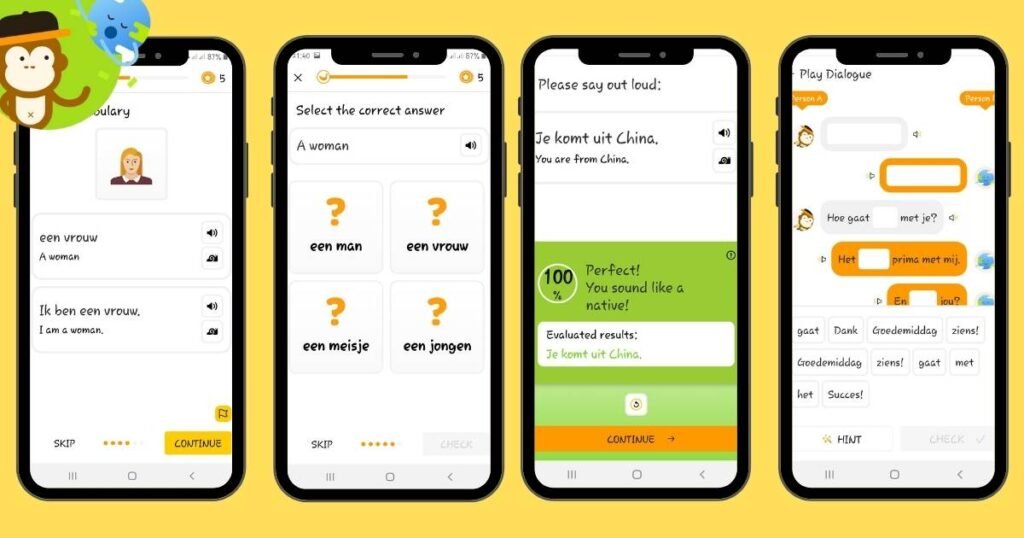
METHODOLOGY
So how does the app actually work?
The methodology is based on the ‘drilling method,’ that is, learning through spaced-out repetition.
For example, you will hear the word ‘a woman’ and then see it used in a sentence, for example ‘I am a woman.’ You then repeat the vocabulary through several other exercises such as multiple choices, which is pretty standard for apps. Seeing a word used in a sentence is the recommended practice when acquiring new vocabulary so that’s a plus.
However, at no point do we learn grammar rules. This isn’t explained anywhere so we’re just left guessing and deducing. So the ‘you’ll never forget a grammar rule again’ doesn’t stand to scrutiny. You might never forget that ‘een vrouw’ is a woman in Dutch, but as someone who’s never studied Dutch before, I can only assume ‘een’ is a feminine article. That’s assuming that I even know what an article is, that my mother tongue has articles at all, how they are used, etc.
From over a decade of experience, we can safely say that most English speakers don’t know what the is, nor how it could translate into other languages and why. Once they understand it, everything suddenly makes sense, and the use becomes much easier and logical, which is a crucial step in overall accuracy in production and eventual fluency.
In the Ling app, we do see different verbs used both in singular and plural, but I’m none the wiser about how the verbs in Dutch are conjugated, what are the endings, the exceptions, the irregular verbs, how many types of verbs are there, or what are even verbs?
Ling app on the side, how are we supposed to independently use these things in varied contexts if we don’t understand them and struggle to identify them to begin with? Most of the methodology on the Internet these days will claim the answer “because children learn like that”, one we have already disproven as nothing but a convenient marketing scheme that promises quick and easy and guarantees only one thing: high turnover for the company.
Learning a language is like building a pyramid – the foundation is arguably the most important part. If it’s not solid, the entire construction will fall apart or it will look wonky.
THE INTERACTIVE BOT AND THE PRONUNCIATION
The app has the interactive bot, meaning you can choose words to fill in the gaps in your part of the dialogue and the bot will answer. The problem with this is that you’re not actually speaking to a person so it’s not so much about developing interactive skills as it is about learning and repeating some well-established phrases.
One of the biggest downfalls of language apps is the fact that they rarely teach you the rules of pronunciation, you can only listen to the pronunciation of different words and sentences. Ling App does have an integrated speech recognition system exercise where you have to repeat the word out loud and you’re given feedback.
There are two problems with that, though:
- You’re still just hoping for the best and not actively applying rules
- If you live in a country where you often have to talk to a robot on the phone instead of a person, even if you’re a native speaker, you will know well what we are referring to
And if you don’t, here is the famous video of a Scottish woman arguing with Alexa:
DOES IT DELIVER ON ITS PROMISES?
According to Ling App’s FAQ section, you can learn a language from apps if those apps cover all four language skills (speaking, listening, reading and writing) and become proficient in all of them. This statement is true from the linguistic point of view, but it’s about how those skills are incorporated that counts.
For example, developing writing skills through Ling App means simply tracing the letter on the screen with your finger. Being based in Asia, the team probably has a much better understanding of how to learn character languages such as Chinese, which are notoriously bad on Duolingo.
That aside, knowing how to write letters in your target language’s alphabet doesn’t equal written expression. Writing skills means being able to produce letters, essays, emails, etc., and convey your thoughts, feelings and experiences independently (not relying on pre-learned phrases) and in different registers (formal and informal). This is something you build up on gradually in any classic language course.
The same can be said for the other skills: you’re not actively speaking to another person at any point, you’re not listening actively nor to complex audios in different accents, and you’re not reading any larger pieces and developing reading comprehension through them with supportive and well-targeted activities. Most importantly, you are not taking everything that has been offered in input and applying in varied contexts, independently, on demand, both targetedly and randomly.
In conclusion, Ling App can be used as a solid complimentary part of your learning, but never as a sole means to the end, especially if your goal is to become proficient. Its strong point is the vocabulary due to the repetitive nature of exercises although this is true for all apps. This is especially useful for people who want to learn a less common language as it’s much less likely they will find resources for reinforcing the knowledge of vocabulary like flashcards.
Some learners have reported seeing errors for some languages, though, such as capitalization in German, which might be a side effect of adding so many languages in such a short period of time so beware of that.
PROS:
- less common languages available
- no limitations based on native language
- tracing alphabet option
- new words in a context
- accurate idea of how languages are learnt
CONS:
- reported grammar errors for some languages
- lack of cultural context and grammar
PROMOVA APP (WORD BOOSTER)
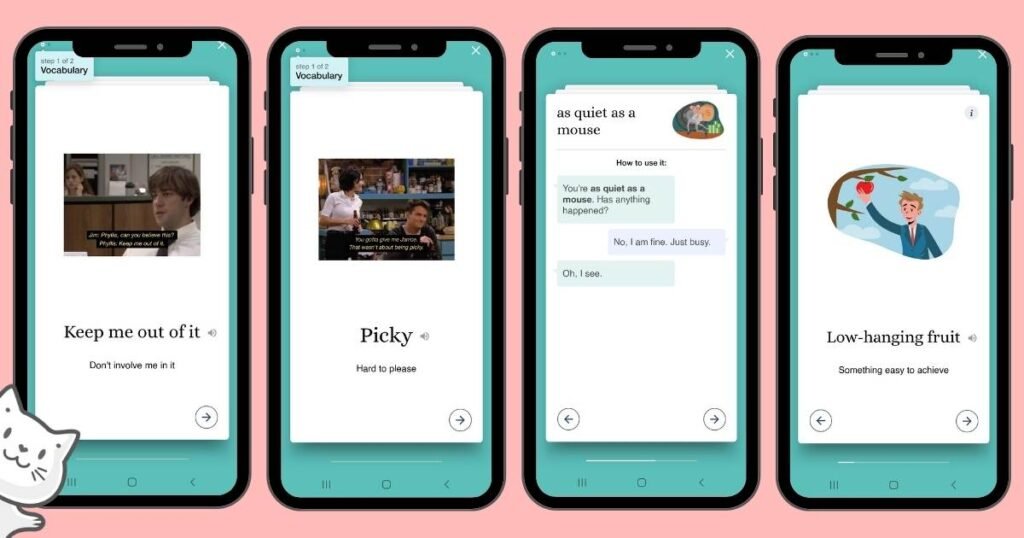
Promova is an app that isn’t talked about or reviewed nearly as much as the other apps so far, but you might stumble upon one of the many adds for it just like I did. What peaked my interest was the premise of a podcast-based application that allows you to discover new words as you listen – at least that’s what the add implied. I thought that sounded different and innovative as podcasts aren’t usually integrated into the app itself so I decided to give it a go.
ADVERTISMENT ISSUES
The first thing that stood out to me once I downloaded the app was that there was no free trial like with all the other apps.
Still, I paid around £6 fee for a week because I really wanted to try this unique feature. I selected my level of Spanish, my interests and goals for a personalized plan. However, I was then led to the course that included flashcard lessons on greetings, the verb ‘to be,’ that is, very basic grammar that then progressed to more complex, but still nowhere close to C2. It is stated on their website that this app is for A2-B2 students. The levels, however, aren’t divided into separate courses so you get all the content in one place. Therefore, there is no personalization.
But wait, what about the podcast feature? That was exactly my question, too. There was no podcast anywhere in the app, just the standard flashcards, repetition, tests and fill-in-the-blanks exercises.
I searched on Google and Spotify thinking I might had misunderstood something, but found nothing. In the end, I resorted to contacting the customer service. To be fair, they got back to me quickly, but this was what they said:
We appreciate your interest in our application and podcast-listening feature. Please, be advised that we were forced to temporarily recall this feature, and now it is under development. It is needed to make sure that the feature will work properly for the best user experience. We sincerely apologize for the inconvenience and hope to release this feature as soon as it is completely ready.
Apart from that, I also enquired about some of the other features mentioned on their website, like the video and visual associations feature.
At the moment, the Spanish version of the app contains only English videos. Spanish videos now are under development. Hopefully, all the videos will be translated into Spanish in the near future.
WHO IS BEHIND PROMOVA APP?
My impression was that this was a fairly new application that was still under development, but the fact that it charged trial for under-developed courses and the misleading add really put me off.
So how new is this application, how many subscribers are there, what is the policy and the ethos of the company?
Websites usually have About us page where information like company values and information are disclosed but I found no such page on Promova’s website. It’s based in Cyprus thanks to the footer of the email and the Terms and Conditions Agreement, but I had to really dig for it.
I was left not knowing who the founder was, who designed the lessons, what was the company motto and when and how the idea for the app came to be.
I also came across a lot of reviews saying the app is a scam and that they were charged the full price at the end of the trial period even though they had cancelled mine on time.
SOME GOOD FEATURES
Because I wanted to get my money’s worth, I decided to check out the English course. I assumed it would the most developed one and I was right.
There’s the General English Course, English with TV Series, Business English and Travel English. My guess is that the ‘personalized plan’ would have taken you to one of those courses, since you are asked about the purpose for learning the language in the beginning, but these courses are only available for English.
That being said, there are a lot more features for English in between the generic vocabulary and grammar lessons, like collocations from Pride and Prejudice, Sounds from Lord of the Flies, Appearances in Anna Karenina, Curious verbs from Jane Eyre, colloquial expressions from popular TV shows like Friends, Viral Memes, 12 Synonyms to Spooky, Internet Slang…
There is also the reading comprehension section with excerpts from novels. You’re supposed to get the definition of the words when you click on it, but we can only guess this is another thing waiting to be updated.

Words like ‘rubicund’ and ‘disparity’ definitely belong to a more advanced vocabulary and knowing colloquial expressions like ‘hangry’ is also a mark of a more natural and fluent speaker so I thought this part was done well.
Another feature I can appreciate is the writing skills section because it actually teaches you about the structure of emails and types of registers (formal and informal) and email etiquette. Written expression is tricky with apps and independent learning in general, because someone does have to read it, correct it and give you the crucial feedback necessary for learning to occur, but Promova at least didn’t neglect this aspect of learning completely like other apps.
You do have the option to purchase monthly group sessions for 49,99 USD / month (2x per week).
According to the website, all the tutors are certified teachers. I did appreciate that they weren’t selling their teachers on the ‘native speaker so the qualifications don’t matter’ basis like a lot of schools do, but on the actual qualification.
You also have the option to participate in the free conversational classes with other students that take place every Saturday and you can see the list of topics for discussion on the website.
SHOULD I TRUST PROMOVA?
All in all, I feel conflicted about Promova app.
I think the amount of colloquial speech, idiomatic expressions as well as literally vocabulary makes it more varied and interesting in comparison with other apps. But as I said, this is limited to the English course while other languages are still very rudimentary.
They’re also very pricey for an app: the subscription renews weekly for $9.99!
I debated whether I should include the review about this app, but I opted to do it in the end for two reasons:
- I myself couldn’t find a review on this app to help me understand it better and see if someone else had the same experience
- Even though there were things I liked about the app, I wanted to include a sort of a cautionary tale to help you navigate through a very saturated and often deceiving market of language learning
When researching about an app or a course, you must know what to look for and what to look out for. So look for transparency, the company ethos, and if you like what you hear, give it a go and see if they actually come through.
Considering that this is the only app I paid for and didn’t get the feature that I came for in the first place, and that this is still being advertised, I was left disappointed.
PROS:
- good additional content for English
- creative approach to learning through an app
- slangy and useful vocabulary within authentic and well-known context
CONS:
- lack of transparency and problems with advertisement
- missing features
- no personalized plan
- pricey subscription
LINGA: BOOKS WITH TRANSLATIONS

Don’t get fooled by the order – the last app on the list was actually my favourite one. Never heard of it? Linga App is the only app with truthful claims – it is there to help you to learn a language. It makes no false promises which speaks volumes about company’s integrity.
With 50K+ downloads on the Google Play store, this app has a very small following in comparison with giants like Duolingo. I can think of two reasons for that:
- it launched in 2020 so not so long ago, and while you can see Duolingo’s owl plastered on taxis in London, Linga app isn’t as heavily advertised nor promoted as the best way to learn a language
- it seems that the team behind the app has an awareness that this app can’t be the only tool for learning a language, as it focuses on just one aspect of learning, and that is comprehensive reading
It is, however, a very powerful tool.
If you’re a regular visitor to our blog, then you know how much emphasis we put on the written word.
In a language learning market that predominantly wants you to start from the output (speaking and writing), we’d like to invite you to slow down and work on the input (reading and listening) so that your output has a solid foundation, accuracy and confidence that will eventually lead to high levels of fluency.
BUILDING YOUR WORD BANK
How does Linga App help you to develop reading comprehension?
If you speak Spanish, Russian, Italian, French, English or German, you will find a library with over 1000 books. However, one of the best things about Linga, is that you can also import your own books. The level of difficulty is marked for each book according to the CEFR scale.
So how is reading in this app different to regular reading?
The app has an in-built dictionary that is very user friendly, so all you have to do is tap on the word to see the definition. Linga takes it one step further, and allows you to see these words used in varied context and to find its synonyms which will help you understand nuances in meaning. It also offers grammar overviews, like conjugations of verbs. At the bottom there’s the +add to dictionary option.
The translation of the words is available in 22 languages, so your might be able to translate words to your mother tongue.
You have the option to manage the words you add into your own personal dictionary, by combining them into groups, setting up reminders for repetition and repeating them through six types of interactive exercises: flashcards, writing what you hear, selecting what your hear, rearranging the letters, choosing the right definition based on the word you hear, and selecting what you hear. Linga is an app that executes vocabulary building very nicely, as effective as an app could make it.
Additionally, you can set up goals, e.g., if you want to learn 10 words per day, and you can also choose whether you want to practice just the words added that day or set up a random combination of words from your dictionary – think of the shuffle option on Spotify.
The app measures everything for you: the number of words you have learned so far, the number of words in progress of learning, your reading time, your reading speed…It cannot offer you the crucial feedback on your functional skills that is necessary for learning, but it does help you track your learning. If you’re the type of person who loves knowing all these facts about themselves, then you’ll love the app.
As someone who is fluent in 5 languages, I can testify that Linga’s methodology could be very effective for comprehensive reading and vocabulary building, as I did a very similar thing in my own learning process.
I would write the title of the book in a small dictionary notebook and write out all the new words. I would revist my list regulary and reread the words – repetition is the key when it comes to vocabulary, along with learning and using within authentic context. Both of these factors Linga App successfully incorporates, alongside active reading (extracting words, analysing them, reapplying them, etc.).
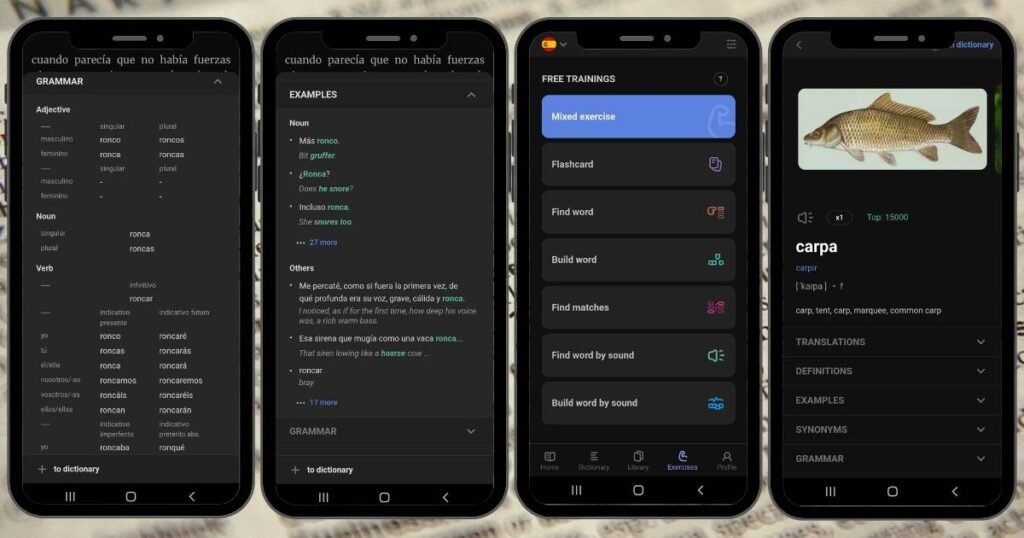
LINGA APP ON THE LANGUAGE LEARNING MARKET
But how does it measure up to the other apps?
The app is obviously designed differently and its focus is on expanding your vocabulary bank through active reading, but the fact is that all of the apps are very vocabulary-oriented, with less focus on grammar. The obvious advantage with Linga is that you will always see the word used within an authentic and varied context, as well as an opportunity to analyse, collect and use the words further.
Then there’s also the fact that, in order to read a book, you can’t be an absolute beginner, so less people will sign up for it because most people who are learning languages are, in fact, beginners. Only a certain percentage of learners will actually get to the intermediate level, and even less to the advanced.
On Linga, there is no gamification, so our modern-day short and snappy focus that most people have will not do well on this app. However, we challenge you to retrain your brain to stop expecting everything instantly and to enjoy the process of learning, that is, by nature, slow.
There are no points earned to keep you hooked, and to keep you entertained, although there is a sense of accomplishment through reaching your set goals, similar to the Goodreads goals.
Apart from books, you also have the possibility of reading leading newspapers and magazines with the help of the app, so that adds a cultural component that most apps just don’t do well, or don’t do at all.
Linga App does immersion the way immersion should be done – to give context to everything, and to aid overall learning.
LINGA APP BEGINNINGS
The Linga website is simple and clear, but I would have liked to see an About us page.
The founder, a senior software engineer Andrei Savchuk is on LinkedIn, alongside his modest announcement on the launch of the app. Linga was created by a group of friends and is based in Berlin, Germany.
Another thing I’ve noticed is that you’re constantly invited to give feedback on how to improve the app so there’s an element of modesty involved that every educator should possess.
I’m sure you’ve come across adds for language learning apps that sound downright bombastic, promising fluency in record time – all it takes is 15 minutes a day, you don’t even have to be awake…
If we compare Linga app with Promova, for example, Promova does teach you some more complex words and idiomatic expressions in English. However, you can go through all of those flashcards, including spaced out repetition, within a month, and that’s it, you will find yourself at the end of the line.
With books and newspapers, there is no limitation to how big your word bank can grow. About other benefits of learning a language through reading, you can check out our article dedicated to that topic.
In conclusion, Linga is an app for serious learners who have already reached at least A2 level.
It allows you to measure and pace your progress and gives you insight into how many words you’ve learned. And the price doesn’t hurt either: after a free trial, you can opt to pay £2,79 monthly, which is the price of a coffee, £24,49 annually or £48,49 for a lifetime subscription.
PROS:
- importing your own books
- it’s seen as what it is – a great tool to aid your learning
- no bombastic, outrageous and false claims
- plenty of real-world context, newspapers and magazines as an addition
- tracked progress
- building your own dictionary
- very affordable subscription
- amazing for serious learners
- an effective methodology for active reading that develops vocabulary and production
CONS:
- focused on just one aspect/skill of language learning
Language learning apps are one of the most googled, discussed and sought out tools in the language market. Their growth in popularity is proportional to the rise of misinformation circulating about how to learn a language. This is especially true for the Duolingo app, which is highgly addictive due to its gamification aspect and accessible to everyone because it’s free.
We’ve tested out language learning giants, namely Duolingo, Babbel and Rosetta Stone as well as some of the less known apps. Even though there were some things we did appreciate like the cultural context and grammar tips in Babbel, we wouldn’t recommend any application as the only way to learn a new language.
The problem with apps is that they go against the very nature of language.
Languages are, generally speaking, incredibly flexible and constantly evolving. They’re like a living organism much like its people. The apps, however, focus predominantly on just one aspect of language learning and that is repetition. While it is true that it takes a lot of spaced-out repetition to acquire a language, especially when it comes to vocabulary, that’s not all it is. Language apps will mostly teach you pre-rehearsed sentences that you will repeat like a parrot, unable to communicate original thoughts and feelings.
If you’ve ever called customer service only to be greeted by a robot, then you know what we’re talking about and how frustrating that can be. Only in this case, the robot is you.
All these apps differ in one feature or the other, but the end result is the same. People will be able to ask for a receipt in a foreign restaurant, but God forbid something out of the ordinary happens, like the card reader not working, and they find themselves lost in translation. Therefore, the only conversation they can participate in is a disjointed one.
It is still, incredibly hard for any language learning app to equip you with the most important aspect of fluency – independence. That comes with targeted, critical, active learning and a sound methodology that you can either seek out and develop yourself, or with a tutor. Most importantly, hard work cannot be escaped if you are aiming for high levels of accurate fluency worthy of a native speaker.
Bear in mind that language learning apps’ target demography are people who generally haven’t got a clue about learning a language. They’re marketed as ‘all you need to learn a language,’ ‘the world’s best way to learn a language,’ which all sounds appealing but it’s far from the truth.
Sellers will do what they’re here to do, and that is to sell. We can’t do anything about that, but we can talk to experts and educate ourselves so we can make the right choice for ourselves.
Always study the company’s ethos and methodology and make sure they deliver on their promise.
Make sure that you have standards for yourself, too. A lot of people fall into the trap of the illusion of fluency because they don’t really know what it means to speak a language, which stems from not knowing what it takes to learn it. Without personalized quality feedback, we can all be guilty of that.
SHOULD YOU STAY AWAY FROM LANGUAGE LEARNING APPS?
Absolutely not.
We’re not saying that you should never use an app as an additional tool to your learning, some of them, like the Linga App, do a better job than others. Just know them for what they are and not for what they’re painted to be.
You could use one of the better apps like Babbel just to introduce you to a language and give you a bit of a cultural context.
If you’re learning a much less common language, you could use flashcards from an app like Ling App, since those resources will be more difficult to find for a language that isn’t as represented.
And as always – know yourself, your strengths and weaknesses, your unique situation and needs, and make sure you always learn with understanding.
LEARN SPANISH WITH RLC
Want to take a language course with your significant other? Perhaps you want to travel with your friends? Or engage in a family learning activity on Saturdays? Our small group learning with a discounted price for families and friends is the perfect learning option for you!
With over 13 years combined of qualifications and experience teaching Spanish at universities and language schools across Europe, we are immensely dedicated to our craft, Spanish language, culture and education. We teach Spanish through a carefully planned out and well-tested method that has brought desired results to all our students.
Book a FREE Educational Assessment and meet us with no need to book any lessons at the end!



